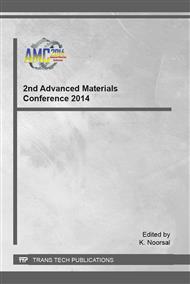[1]
P. Naphon, D. Thongkum, P. Assadamongkol, Heat pipe efficiency enhancement with refrigerant-nanoparticles mixtures, Energy Conver Manage. 50 (2009) 772-776.
DOI: 10.1016/j.enconman.2008.09.045
Google Scholar
[2]
S.N. Khadzhiev, K.M. Kadiev, G.P. Yampolskaya, M.K. Kadieva, Trends in the synthesis of metal oxide nanoparticles through reverse microemulsions in hydrocarbon media, Adv. Colloid Interface Sci. 132 (2013) 197-198.
DOI: 10.1016/j.cis.2013.05.003
Google Scholar
[3]
S.U. Ilyas, R. Pendyala, N. Marneni, Preparation, sedimentation and agglomeration of nanofluids, Chem. Eng. Technol. 37 (2014) 2011-(2021).
DOI: 10.1002/ceat.201400268
Google Scholar
[4]
S.U. Ilyas, R. Pendyala, N. Marneni, Settling characteristics of alumina nanoparticles in ethanol-water mixtures, Appl. Mech. Mater. 372 (2013) 143-148.
DOI: 10.4028/www.scientific.net/amm.372.143
Google Scholar
[5]
D. Kwek, A. Crivoi, F. Duan, Effects of temperature and particle size on the thermal property measurements of Al2O3-Water Nanofluids, J. Chem. Eng. Data. 55 (2010) 5690-5695.
DOI: 10.1021/je1006407
Google Scholar
[6]
S.U. Ilyas, R. Pendyala, A. Shuib, N. Marneni, A review on the viscous and thermal transport properties of nanofluids, Adv. Mater. Res. 917 (2014) 18-27.
DOI: 10.4028/www.scientific.net/amr.917.18
Google Scholar
[7]
C.J. Ho, L.C. Wei, Z.W. Li, An experimental investigation of forced convective cooling performance of a microchannel heat sink with Al2O3/ water nanofluid, Appl. Therm. Eng. 30 (2010) 96-103.
DOI: 10.1016/j.applthermaleng.2009.07.003
Google Scholar
[8]
M.J. Pastoriza-Gallego, C. Casanova, J.L. Legido, M.M. Piñeiro, CuO in water nanofluid: Influence of particle size and polydispersity on volumetric behaviour and viscosity, Fluid Phase Equilib. 300 (2011) 188-196.
DOI: 10.1016/j.fluid.2010.10.015
Google Scholar
[9]
P.K. Namburu, D.K. Das, K.M. Tanguturi, R.S. Vajjha, Numerical study of turbulent flow and heat transfer characteristics of nanofluids considering variable properties, Int. J. Therm. Sci. 48 (2009) 290-302.
DOI: 10.1016/j.ijthermalsci.2008.01.001
Google Scholar
[10]
A.E.H. Masuda, K. Teramae, N. Hishinuma, Alteration of thermal conductivity and viscosity of liquid by dispersing ultra-fine particles (dispersion of Al2O3, SiO2 and TiO2 ultra-fine particles), Netsu Bussei. 4 (1993) 227-233.
DOI: 10.2963/jjtp.7.227
Google Scholar
[11]
J.A. Eastman, S.U.S. Choi, S. Li, W. Yu, L.J. Thompson, Anomalously increased effective thermal conductivities of ethylene glycol-based nanofluids containing copper nanoparticles, Appl. Phys. Lett. 78 (2001) 718-720.
DOI: 10.1063/1.1341218
Google Scholar
[12]
X.W. Wang, X.F. Xu, S.U.S. Choi, Thermal conductivity of nanoparticle-fluid mixture, J. Thermophys and Heat Transfer. 13 (4) (1999) 474-480.
DOI: 10.2514/2.6486
Google Scholar
[13]
S.U. Ilyas, R. Pendyala, N. Marneni, Dispersion behaviour and agglomeration effects of zinc oxide nanoparticles in ethanol–water mixtures, Mater. Res. Innov. 18 (2014) S6-179-S6-183.
DOI: 10.1179/1432891714z.000000000953
Google Scholar
[14]
N. Masoumi, N. Sohrabi, A. Behzadmehr, A new model for calculating the effective viscosity of nanofluids. J. Phys. D: Appl. Phys. 42 (2009) 055501.
DOI: 10.1088/0022-3727/42/5/055501
Google Scholar
[15]
C.T. Nguyen, F. Desgranges, G. Roy, N. Galanis, T. Mare, S. Boucher, H. Angue Mintsa, Temperature and particle-size dependent viscosity data for water-based nanofluids - Hysteresis phenomenon, Int. J. Heat Fluid Fl. 28 (2007) 1492-1506.
DOI: 10.1016/j.ijheatfluidflow.2007.02.004
Google Scholar


